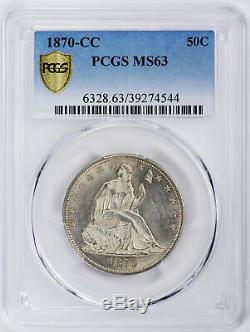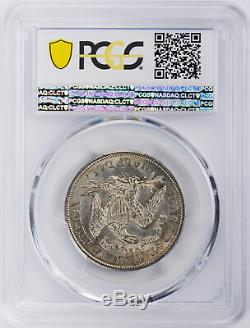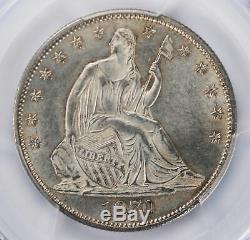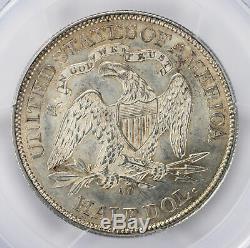1870-cc Liberty Seated 50c Pcgs Ms 63






1870-CC LIBERTY SEATED 50C PCGS MS 63. The late 1830s were years of great ferment, progress, growth and change for the United States Mint.
Steam-powered coinage made its debut in 1836. The first branch mint opened in New Orleans in 1838, and new designs were placed on all the gold and silver coins between 1837 and 1840. The technical and artistic advancements were interrelated, for it was the introduction of steam power that stimulated Mint officials to update the coinage aesthetically as well. On the silver coins, the new look took the form of a seated figure of Liberty with her right hand resting upon a shield and her left hand grasping a staff topped by a Liberty capsymbols of preparedness and freedom. Thirteen stars are arrayed around her, and the date is below. This design first appeared on pattern and regular-issue silver dollars in 1836, and thereafter was adapted for use on all the remaining silver coins: the half dollar, quarter dollar, dime and half dime. This Seated Liberty design (interchangeably known as the Liberty Seated type) was fashioned by noted portraitist Thomas Sully and executed by Mint engraver Christian Gobrecht, a man of great technical skill. Its neoclassical appearance accurately reflected Americans artistic taste in the mid-19th century and, indeed, nearly to the threshold of the 20th century, for thats how long it lingered on three of the coins before giving way to the Barber design in 1892. The half dollar was the last of the five coins to get this new design. Well into 1839, new fifty-cent pieces continued to bear the Capped Bust likeness of Liberty long viewed with affection by collectors. Since 1836, however, Capped Bust halves had lost a key part of their earlier distinctiveness and charm because they were being made on a steam press and with reeded edges, rather than the old-style lettered edges.The so-called Gobrecht dollars of 1836-39 wedded the Seated Liberty obverse to a breathtaking reverse featuring a majestic flying eagle. This was the work of another exceptional artist, Titian Peale, again with the die work by Gobrecht. Unaccountably, though, this magnificent design was scrapped when the art work was adapted for the smaller silver coins.
Then, in 1840, it was dropped from the dollar as well. Mint officials chose instead to use essentially the same reverse on the half dollar and quarter as the one that had appeared on their Capped Bust counterparts.Again, the central device was a naturalistic eagle with a shield superimposed upon its breast. UNITED STATES OF AMERICA is inscribed above the eagle on each of these coins, and the statement of value appears below. On the fifty-cent piece, this takes the shorthand form HALF DOL. The Philadelphia Mint struck nearly two million Seated Liberty half dollars in 1839, the first year of issue, and these come in two major versions.
Coins produced from the very first obverse die show a larger rock upon which Libery is seated and no trace of drapery at the crook of her elbow, while subsequent strikes all exhibit a fold of drapery there (unless they have undergone excessive wear). The No-Drapery pieces are scarce in every grade and flat-out rare in mint state levels of preservation.
Seated Liberty halves remained in production for more than half a century, from 1839 through 1891, and mintages generally ranged between 500,000 and two million, with higher peaks and lower valleys. The series unusual length makes it somewhat unwieldy to collect. Partly for that reason, hobbyists have divided it into several sub-categories. Perhaps the most important division is the one between No Motto and With Motto examples. The motto in question is IN GOD WE TRUST, which first gained a place on United States coinage during the Civil War. In 1866, the Mint added this inscription to the half dollar, placing it on a banner above the eagle. It remained there throughout the remaining quarter-century of the coins production. Two other major varieties loom large in the 27-year life-span of No-Motto Seated halves. Both were direct results of the California Gold Rush, which totally upset the delicate balance the Mint had been striving to maintain in the relative values of gold and silver in U. This gold, in turn, could then be exchanged at face value for more silver coins. The item "1870-CC LIBERTY SEATED 50C PCGS MS 63" is in sale since Saturday, April 4, 2020. This item is in the category "Coins & Paper Money\Coins\ US\Half Dollars\Seated Liberty (1839-91)". The seller is "rarecoinwholesalersca" and is located in Irvine. This item can be shipped to United States.- Strike Type: Business
- Certification Number: 39274544
- Grade: MS 63
- Circulated/Uncirculated: Uncirculated
- Certification: PCGS
- Mint Location: Carson City


